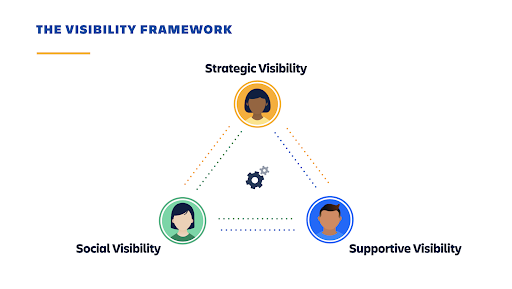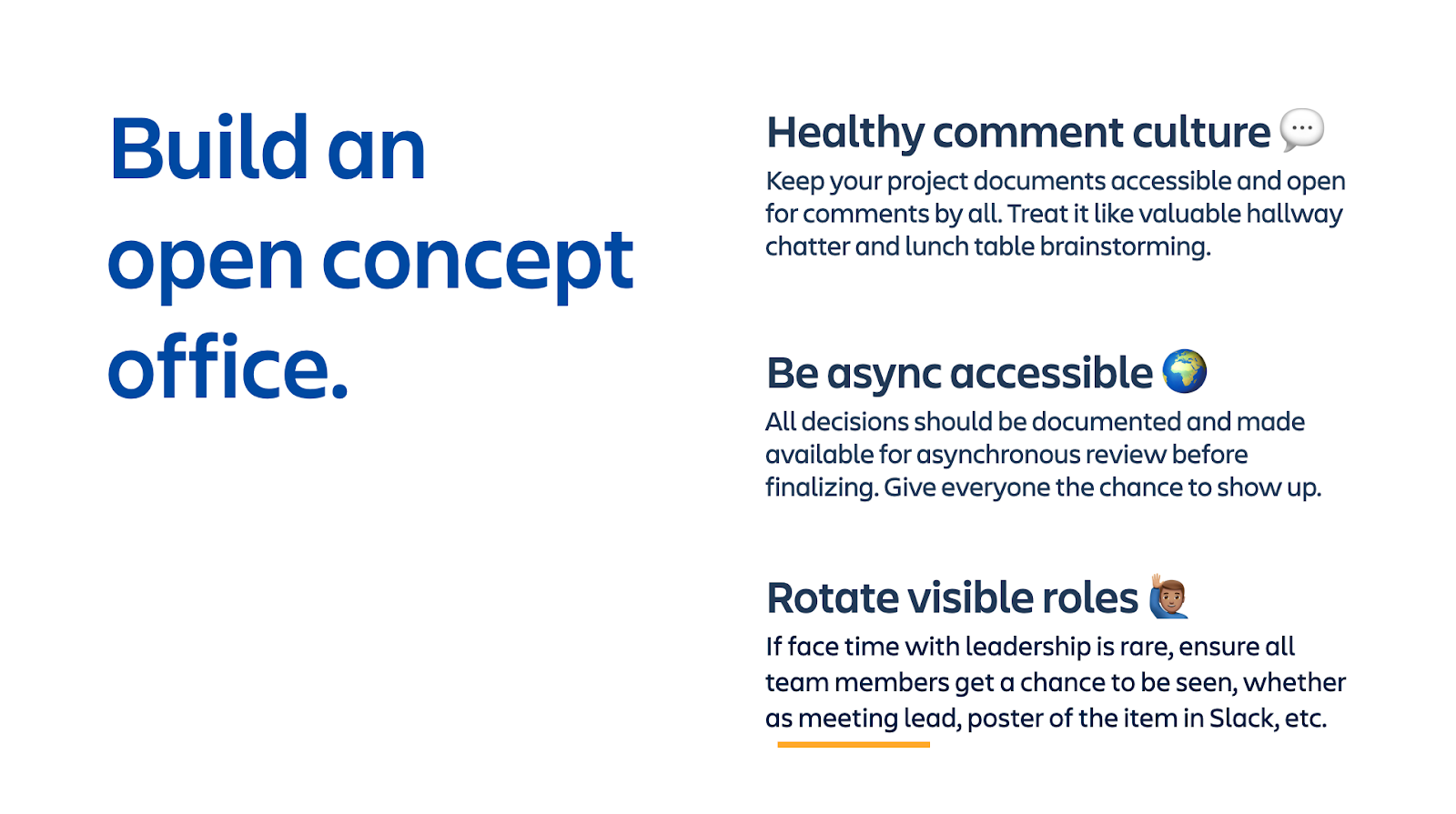Visibility at work—being included, recognized, and valued by networks within your organization—is extremely important for career success. It’s how you get proper credit for your work, get considered for advancement, and build influence in professional circles.
It’s equally necessary for teams to thrive and succeed as a unit. Research shows that remote team members who don’t feel “seen” are less collaborative, innovative, and supportive of each other.
Remote teams are facing a big visibility problem. Isolation from company culture, lack of face time with management, fewer informal networking opportunities, time zones, and technological hurdles all play a part in disrupting the opportunities for you and your team members to be visible to one another and to others within the company.
So, why are we not talking more about visibility as a vital remote team skill? There are many factors involved, but here are a couple reasons to consider:
- It’s a little awkward to say we’re intentionally manufacturing ways to be noticed. It feels like we’re trying too hard. We’d all love to just do good work and be noticed for it, but unfortunately we don’t live in a world where that always happens.
- When you’re co-located, you can take visibility for granted! Whether it’s social chatter at lunch, picking up on body language in a meeting, or seeing when your reports clock out for the day, constant contact with your team in a physical work environment creates visibility faster and with more depth than for remote teams.

By focusing on this unspoken “v-word” as a valuable remote work skill to build—and building a culture of visibility that’s equal for all—your remote team will forge better relationships, build more empathy, improve collaboration and support, as well as foster better ideas and stronger results.
Focus On Face Time
Does working as a team in one physical location improve our professional development? Researchers Ioana Cristea and Paul Leonardi published a study in 2019 that looked at the impact of face time on work relationships.
When employees are geographically distributed from managers who control the assignment of work, they are often unable to display face time. – Ioana C. Cristea & Paul M. Leonardi
This is a pretty obvious statement: Remote workers get less face time with managers than co-located employees. And the study found that there can be real repercussions to this.
Their research found that those who get more face time with management by being co-located are:
- Assigned better work assignments from their managers
- Awarded promotions more frequently
- Generally more unaware of their remote counterparts when considering the above opportunities.
In particular, co-located managers and employees don’t register the added level of effort that it takes for remote workers to engage with them at the same level in order to achieve the same results. Cristea and Leonardi call this added level of effort a “sacrifice” on the part of the remote worker because it takes more hours at the desk, more accessibility in off-hours, and simply, more hard work to achieve professional parity with in-office colleagues.
Creating a truly equitable environment for professional opportunity is what the visibility problem with modern remote teams is about: Fair observation of effort invested, acknowledgement of their contributions, and consideration for promotions and work assignments.
As remote workers, we want to feel seen. Many companies have learned how to integrate remote work into their business almost over night—now it’s time to set up structures to support the visibility and growth of remote teams for the long haul.
Proximity Is Merely Perception
So, how do you build a culture of visibility with your remote team?
First, it’s important to understand that the concept of “being visible” has two definitions. It can mean being “perceptible to the eye” (which is great for colocated teams) while also meaning “constantly or frequently in public view.” One is the physical side of being visible, and the other is the human-created social side of being recognized and known to others.
At work, the definition of visibility thus becomes “the state of being included, recognized, and valued by others at work.” When teams are co-located in an office, this might seem pretty basic or unimportant as a concept but it becomes a pretty big factor in the remote workplace.
The key to manufacturing visibility in remote organizations is perceived proximity.
Perceived proximity: Our cognitive and emotional sense of connection affects relationship quality more than physical distance.
Perceived proximity is the concept that if we feel connected to others mentally and emotionally, that sense of connection can have a greater impact on our relationships than our physical distance.
For example, you might have family or friends that live on the other side of the country, but you probably feel more connected to them than your next door neighbor. That’s because you work at it—you make phone calls, discuss what’s happening in your lives, you give them space in your world and see them in it. At work, calling out this connection as something we have to intentionally develop will help us. But how do we intentionally create perceived proximity with our remote teams?

The researchers who developed the perceived proximity model looked into how it happens. Here are the secret sauce ingredients for creating a digital office that feels as connected as a physical one:
Communicate frequently
- Cultivate a shared identity and purpose
- Be dependable, reliable, and accessible
- Connect with others authentically
If you think about it, these are all factors that make a great physical work environment: You can depend on people to show up day after day, you feel comfortable talking with them anytime, regardless of rank, you actually like spending time with them and you feel accepted as yourself.
It’s all-too-easy to be all business, all the time in a remote workplace when your only interactions are periodic video meetings and email status updates about work. It can feel much more awkward to ping the CEO a question in chat when you’ve never seen them in the lunch line or said hi to them in the hallway. Remote teams are especially at risk for being more reserved, more buttoned up, and more quiet on the whole because they aren’t automatically being put in interpersonal situations where those interactions can happen naturally.
Remote teams need consistent, inclusive interactions—but they need to be the right type, done in the correct way.
Enter, The Visibility Framework

I’ve developed the “Visibility Framework,” a set of three practical pillars to make it easier for my remote team to think intentionally about how visible they are during the workday:
- Social Visibility: Fostering positive personal connections and building relationships with coworkers through social interactions (and yes, that’s on work time).
- Strategic Visibility: Contributing ideas and advice on projects and having a say in business decisions—whether you’re the CEO or the intern.
- Supportive Visibility: Building team members up by recognizing and sharing their good work with others. Creating equal opportunity situations for teams to contribute and collaborate at their best.
Public work spaces for remote teams can include non-private chat channels, Trello boards, Confluence pages or shared documents, and video meetings. Thinking about how often, and in what ways, your team is visible in shared workspaces is the key to building effective visibility.
Social Visibility
Let’s talk about the fun stuff first: Using work time to hang out and share memes with your coworkers. Work time is social time and it’s important to invest in professional relationships.
For many remote workers, it’s hard to make time every day for social interactions. At the office, where do those social moments happen? At the coffeemaker, in the hallway, yes, even the bathroom. None of those places are accessible to remotes. In-office teams have a watercooler, so remote teams should have virtual corners to chat as well.
Here are some best practices I’ve learned from working at Trello:
- Reach out! You have to be proactive about creating social moments. They can be small touches like baking in 5-10 minutes in meetings for weekend catch-ups or DMing people on chat asking for TV recommendations.
- Set a schedule. Standardizing some expectations for socializing can help reinforce the framework: Everyone shares a picture from their weekend on Mondays, or everyone eats lunch together on video on Thursdays, etc. Let your team decide on these schedules, so that they don’t feel forced or top-down.
- Get meta. Review how well (or not well) your team is socializing on a regular basis. When teams get busy and stop with video lunches casual personal chatter on Slack, communication in other areas tends to break down too. We lose empathy. We feel disconnected. Making time for fun, and making time to review and understand how that fun helps us as a team, has been really key for us to maintain a strong bond.

Managers should be explicit that it’s OK to take a reasonable amount of work time to socialize. A company’s ability to encourage remote teams to prioritize social interaction can be helped if there is some measure of team interaction or team connectedness baked into performance reviews. You should not expect everyone to be a social butterfly, but everyone should make an effort to bond and build up the perceived proximity that makes for a strong team.
Strategic Visibility
Now that we’re having fun, let’s look at how to harness that connection for better professional visibility. Strategic visibility encompasses your remote team’s participation in key projects and initiatives, including being proactive about having an opinion on business decisions:
- Are they getting enough face time with management?
- Are they being considered for opportunities as much as their in-office colleagues?
Spend time developing a plan to be visible in front of key stakeholders. The goal here is to create an equal playing field for remotes to contribute and have a say in business decisions. Here are a few things to consider:
- Keep your virtual office doors open wherever possible. This means having a shared set of tools where work happens openly, so that everyone can read the same information and is welcome to comment and participate in business decisions. If you’re isolating work in closed email threads and locked documents, you’re missing out on the valuable innovation that comes from group input.
- Never expect or require immediate participation on key business decisions when time zones are a factor. Always provide options for team members to weigh in or provide feedback asynchronously on a Trello card, Confluence page, or where the work is being tracked.
- Face time in video meetings is probably the closest simulation to in-person interactions, making these opportunities valuable. You wouldn’t keep your junior associates hidden under a desk when the boss walks by: Everyone on the team should get exposure to leadership, regardless of rank, so make a point to rotate visible roles to keep things equitable.

Managers can work with their team reports individually to set a monthly goal for building their strategic visibility where they struggle most: Whether that’s sending out regular updates on their project wins, participating in open company debates, or volunteering to lead meetings.
Supportive Visibility
Remote workspaces can quickly become an echo chamber of unaddressed messages in Slack channels and delayed responses to email. If you asked your coworker a question in person and they didn’t even acknowledge your presence, how would being ignored make you feel? Everyone should know their work is being seen and appreciated, especially because you can’t actually see anyone to know they are there.
The golden rule can be simple: Never leave an effort unacknowledged. This can go a long way to building team trust and respect, as well as ensuring everyone is up-to-date on their team’s progress and accomplishments—something that makes everyone feel good! Here are few ways to better support each other as remote teammates:
- Prioritize remote-first video meetings that give everyone an equal presence. Each attendee should call in from their own computer and have their video turned on. If some of the attendees are co-located, avoid having five people in a conference room, with one giant head calling in on a screen. This makes it easier to hear conversations, read facial expressions, and participate as the remote teammate.
- Give credit where credit is due—always tag the person where work is happening that references them. Digital receipts of recognition are very valuable in today’s work environment as they can be used to build proof points for performance reviews and raise your team’s profiles in front of leadership.
- Responding to each and every team interaction doesn’t have to be cumbersome. Use emoji reactions for a quick show of support! Make it a team rule to never leave a question unanswered or a shared resource unacknowledged in chat.

It’s fairly easy for companies to build programs for sending kudos or highlighting exceptional work done each month. Rewards can include being featured at monthly team meetings, gift cards sent in the mail, or a chance to have a 1:1 meeting with the founders.
See It, Believe It: Be Seen For Your Value
Remote or co-located, no one is immune from struggling with visibility in professional situations. However, remote workers will need to work extra hard on building relationships and recognition because they can’t be as easily “seen” on a day-to-day basis.
Bringing this issue out into the open will help all teams at your company be more aware of each other, and in turn, feel more connected and valued.







































